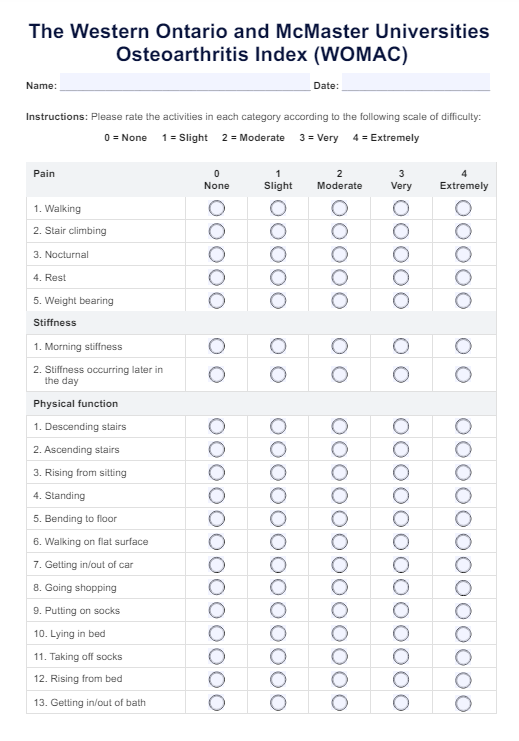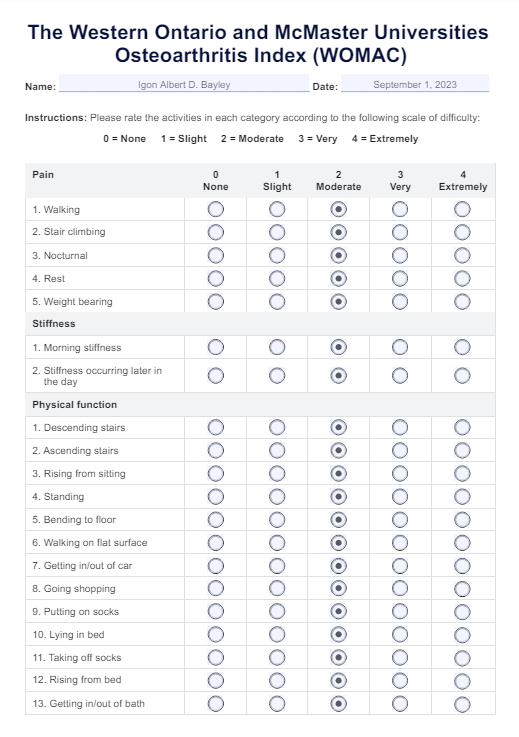WOMAC Osteoarthritis Index
Use the WOMAC Osteoarthritis Index to understand how osteoarthritis affects your patients based on their self-ratings.


What is the WOMAC Osteoarthritis Index?
The Western Ontario and McMaster Universities Osteoarthritis Index, or WOMAC Osteoarthritis Index for short, is one of healthcare professionals' most valuable assessment tools to assess hip and knee osteoarthritis. It is a 24-item list. Professionals hand it out to patients with hip or knee osteoarthritis and have them rate themselves per item.
The 24 items on the WOMAC index are divided into three sections:
- WOMAC pain subscale (five items)
- WOMAC stiffness subscale (two items)
- WOMAC physical function subscale (seventeen items)
These subscales and items revolve around the functional limitations of patients with knee osteoarthritis or hip osteoarthritis and how either one or both affect their activities of daily living, quality of life, and general health and well-being.
How is it scored?
Patients answering the WOMAC index will rate themselves for each subscale based on the difficulty caused by their osteoarthritis. Each item can be rated from 0 to 4:
- 0 = None
- 1 = Slight
- 2 = Moderate
- 3 = Very
- 4 = Extremely
Patients are only allowed to pick one number rating per item.
Once the patient has rated all items, they must submit the report back to the healthcare professional who gave it to them, and then the professional will start calculating the scores.
The healthcare professionals only need to get the sum for each subscale and the total osteoarthritis outcome score.
They must divide the total score by 96 to calculate the final score. 96 is the maximum possible score (if patients rated themselves 4 for all 24 items). The total score indicates the percentage of difficulty osteoarthritis causes in the patient.
Next steps after using this index
The next steps might vary depending on the final score and percentage calculated by the healthcare professional. Conservative treatments might be the best option if the difficulty is low or moderate. These include taking medications like non-steroidal anti-inflammatory drugs (NSAIDs) and acetaminophen. Taking physical and occupational therapy can help restore strength in the hip or knee and find ways to lessen the stress on those joints.
For those with higher final scores and percentages, further testing should be conducted to determine if it would be best for patients to take cortisone/lubrication injections or undergo surgery (hip joint replacement, total knee replacement, or bone realignments). As with all surgeries, risks must be assessed and relayed to patients to help them decide on the treatment they need.
WOMAC Osteoarthritis Index Template
WOMAC Osteoarthritis Index Example
How to use our WOMAC Osteoarthritis Index template
If you want to use the WOMAC Osteoarthritis Index for your osteoarthritis-related work, we'd like you to know that we created a template for it that you can easily download from our template collection!
Our template is easy to use! It comes with editable fields where you can indicate patient information, such as their full name and date of submission.
As for the self-rating portion of the index, the answer choices are set for all items. Usually, printed versions of this index ask patients to encircle their self-ratings; our template comes with radio buttons so they can tick it using a pen (if printed) or a mouse (if you gave them a digital copy).
After the list of items to rate, there will be two blank fields: one for indicating the total score and another for indicating the percentage of how much osteoarthritis causes the patient difficulty. It comes in the form of an equation so healthcare professionals know exactly how to calculate the WOMAC score:
- Total score: ______ ÷ 96 = ______ %
Benefits of using the WOMAC Osteoarthritis Index
Here are some of the benefits of using the WOMAC Osteoarthritis Index:
It can reveal how patients perceive the effects of their osteoarthritis
One of the great things about self-report outcome measures such as the WOMAC index is that they provide healthcare professionals with their patients' perspectives. While professionals can make objective assessments of osteoarthritis, it's also important to know how exactly the patient feels about their ailment and the difficulties they face as a result. Knowing the patient's side of things can help professionals determine the best and most personalized treatment that suits their patient's needs.
It can help inform treatment plans alongside other test results
The final score and percentage calculated by healthcare professionals can be used in the treatment plan creation process to determine the best and most personalized treatment for patients.
If the patient's WOMAC percentage is 100% and other test results show that their osteoarthritis is dire to the point that surgery might be the best way to solve the problem, then discussing surgery with the patient can be part of the next steps after all the assessments. If the percentage is 30 to 50%, perhaps physical and occupational therapy should be added to their treatment plans.
Commonly asked questions
No. It's meant for patients with osteoarthritis to assess the difficulties caused by it.
No. It should be one of several assessments used. This is for getting subjective data on a patient's osteoarthritis. Of course, it's recommended to conduct other tests, especially imaging tests, to see the severity of osteoarthritis and help determine the next course of action.
Yes. If a patient is undergoing treatment for osteoarthritis (medications, physical therapy, etc.), you can use the index to see if they feel that they're getting better. This can help inform treatment adjustments down the line if needed.






















-template.jpg)
















































































